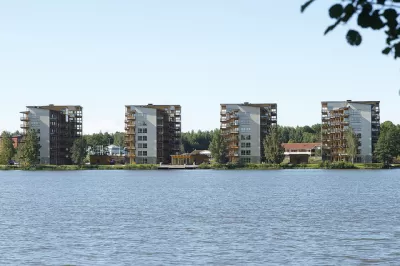Portland, Oregon lives up to its reputation as a testing ground for urbanism innovation by approving what will become the nation's tallest wood framed building.

"An 11-story timber high-rise planned in Portland's Pearl District has been approved for construction," reports Elliot Njus, "a milestone for wood technology that could allow for even taller timber buildings."
"At 148 feet, the Framework building will be the nation's first high-rise building made of wood," adds Njus.
As reported in another article by Njus and Molly Harbarger, Portland is pressing for more wood construction to support the region's timber industry.
Other cities around the world, like Toronto, are allowing larger wood framed buildings because they tend to be cheaper than steel framed buildings. High profile examples of timber skyscrapers have been proposed in Paris and Minneapolis. Skepticism toward the building practice can still be found in the Atlanta suburb of Sandy Springs, however, which recently took steps to limit the construction of wood framed buildings.
FULL STORY: Timber high-rise planned in Pearl District gets construction permit

Trump Administration Could Effectively End Housing Voucher Program
Federal officials are eyeing major cuts to the Section 8 program that helps millions of low-income households pay rent.

Planetizen Federal Action Tracker
A weekly monitor of how Trump’s orders and actions are impacting planners and planning in America.

Ken Jennings Launches Transit Web Series
The Jeopardy champ wants you to ride public transit.

Milwaukee Road to Get Complete Streets Upgrades
The city will reduce vehicle lanes and build a protected multi-use trail including bioswales and other water retention features on its ‘secret highway.’

Tackling Soil Contamination With Nature-Based Solutions
Los Angeles County residents and experts are turning to nature-based methods like bioremediation to address long-standing and fire-exacerbated soil contamination without resorting to costly and disruptive removal.

Rebuilding Smarter: How LA County Is Guiding Fire-Ravaged Communities Toward Resilience
Los Angeles County is leading a coordinated effort to help fire-impacted communities rebuild with resilience by providing recovery resources, promoting fire-wise design, and aligning reconstruction with broader sustainability and climate goals.
Urban Design for Planners 1: Software Tools
This six-course series explores essential urban design concepts using open source software and equips planners with the tools they need to participate fully in the urban design process.
Planning for Universal Design
Learn the tools for implementing Universal Design in planning regulations.
Ada County Highway District
Clanton & Associates, Inc.
Jessamine County Fiscal Court
Institute for Housing and Urban Development Studies (IHS)
City of Grandview
Harvard GSD Executive Education
Toledo-Lucas County Plan Commissions
Salt Lake City
NYU Wagner Graduate School of Public Service



























